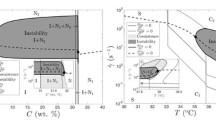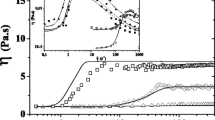Abstract
A mesoscopic simulation method, the “pointer algorithm,” is here shown to capture accurately the rheology of a variety of surfactant solutions, including CTAB/NaNO3, CPyCl/NaSal, and CTAB/NaSal, at different salt and surfactant concentrations presented in the literature. In addition, correlations derived from this method are shown to allow the average micelle length \(\langle L\rangle\) to be estimated from \(\frac{{G}_{\mathrm{min}}^{\mathrm{^{\prime}}}}{{G}_{\mathrm{min}}^{^{\prime\prime} }}=0.317{\left(\frac{\langle L\rangle }{{l}_{\mathrm{e}}}\right)}^{0.82}\) where \({G}_{\mathrm{min}}^{\mathrm{^{\prime}}}\)/\({G}_{\mathrm{min}}^{^{\prime\prime} }\) is the ratio of storage to loss modulus at the frequency where G″ exhibits a local minimum, and \({l}_{\mathrm{e}}\) is the entanglement length, which can be estimated from the modulus. We also obtain from the pointer algorithm a formula whereby the micelle breakage time (τbr) can be estimated from the longest relaxation time (\({\tau }_{\mathrm{R}}\)). The pointer algorithm’s predictions are also shown to match those of a more microscopic slip-spring model, which had been previously validated by comparison to polymer rheological data. Thus, the work provides both a method and example estimates of these parameters as functions of surfactant and salt concentration, filling a major gap in characterization of these solutions. Finally, we investigate the determination of the micelle persistence length from high-frequency data.
Similar content being viewed by others
References
Afifi H, Karlsson G, Heenan RK, Dreiss CA (2011) Solubilization of oils or addition of monoglycerides drives the formation of wormlike micelles with an elliptical cross-section in cholesterol-based surfactants: a study by rheology, SANS, and cryo-TEM. Langmuir 27:7480–7492. https://doi.org/10.1021/la201026s
Agrawal NR, Yue X, Raghavan SR (2020) The unusual rheology of wormlike micelles in glycerol: comparable timescales for chain reptation and segmental relaxation. Langmuir 36(23):6370–6377. https://doi.org/10.1021/acs.langmuir.0c00489
Aswal VK, Goyal PS, Thiyagarajan P (2002) Small-angle neutron-scattering and viscosity studies of CTAB/NaSal viscoelastic micellar solutions. J Phys Chem B 102(14):2469–2473. https://doi.org/10.1021/jp980181f
Bellour M, Skouri M, Munch JP, Hébraud P (2002) Brownian motion of particles embedded in a solution of giant micelles. Eur Phys J E 8(4):431–436. https://doi.org/10.1140/epje/i2002-10026-0
Calabrese MA, Wagner NJ (2018) Detecting branching in wormlike micelles via dynamic scattering methods. ACS Macro Lett 7:614–618. https://doi.org/10.1021/acsmacrolett.8b00188
Cardinaux F, Cipelletti L, Scheffold F, Schurtenberger P (2002) Microrheology of Giant-Micelle Solutions. Eur Lett 5(57):728–744
Cates ME (1987) Reptation of living polymers: dynamics of entangled polymers in the presence of reversible chain-scission reactions. Macromolecules 20(9):2289–2296. https://doi.org/10.1021/ma00175a038
Cates ME, Fielding SM (2006) Rheology of giant micelles. Adv Phys 55:799–879. https://doi.org/10.1080/00018730601082029
Clausen TM, Vinson PK, Minter JR, Davis HT, Talmon Y, Miller WG (1992) Viscoelastic micellar solutions: microscopy and rheology. J Phys Chem 96(1):474–484. https://doi.org/10.1021/j100180a086
Das NC, Cao H, Kaiser H, Sokol PE, Gladden J (2012) Shape and size of highly concentrated micelles CTAB/NaSal by small angle neutron scattering surfactants and micelles. Langmuir 28:11962–11968. https://doi.org/10.1021/la2022598
Galvan-Miyoshi J, Delgado J, Castillo R (2008) Diffusing wave spectroscopy in Maxwellian fluids. Eur Phys J E 26(4):369–377. https://doi.org/10.1140/epje/i2007-10335-8
Gittes F, Mackintosh FC (1998) Dynamic shear modulus of a semiflexible polymer network. Phys Rev E 58(2):1241–1244. https://doi.org/10.1103/PhysRevE.58.R1241
Granek R (1994) Dip in G″(w) of polymer melts and semidilute solutions. Langmuir 10(7):1627–1629. https://doi.org/10.1021/la00017a051
Granek R, Cates ME (1992) Stress relaxation in living polymers: results from a Poisson renewal model. J Chem Phys 96(6):4758–4767. https://doi.org/10.1063/1.462787
Helgeson ME, Hodgdon TK, Kaler EW, Wagner NJ (2010) A systematic study of equilibrium structure, thermodynamics, and rheology of aqueous CTAB/NaNO3 wormlike micelles. J Colloid Interface Sci 349(1):1–12. https://doi.org/10.1016/j.jcis.2010.05.045
Herle V, Kohlbrecher J, Pfister B, Fischer P, Windhab EJ (2007) Alternating vorticity bands in a solution of wormlike micelles. Phys Rev Lett 99(15):158302. https://doi.org/10.1103/PhysRevLett.99.158302
Kalur GC, Raghavan SR (2005) Anionic micellar fluids that display cloud points: rheology and phase behavior. J Phys Chem B 109:8599–8601. https://doi.org/10.1021/jp044102d
Mackintosh FC, Safran A, Pincus PA (1990) Self-assembly of linear aggregates: the effect of electrostatics on growth. Europhys Lett 12(8):697–702. https://doi.org/10.1209/0295-5075/12/8/005
Mandal T, Koenig PH, Larson RG (2018) Nonmonotonic scission and branching free energies as functions of hydrotrope concentration for charged micelles. Phys Rev Lett 121(3):38001. https://doi.org/10.1103/PhysRevLett.121.038001
Oelschlaeger C, Schopferer M, Scheffold F, Willenbacher N (2009) Linear-to-branched micelles transition: a rheometry and diffusing wave spectroscopy (DWS) study. Langmuir 25:716–723. https://doi.org/10.1021/la802323x
Oelschlaeger C, Suwita P, Willenbacher N (2010) Effect of counterion binding efficiency on structure and dynamics of wormlike micelles. Langmuir 26(10):7045–7053. https://doi.org/10.1021/la9043705
Parker A, Fieber W (2013) Viscoelasticity of anionic wormlike micelles: effects of ionic strength and small hydrophobic molecules. Soft Matter 9(4):1203–1213. https://doi.org/10.1039/c2sm27078a
Raghavan SR, Fritz G, Kaler EW (2002) Wormlike micelles formed by synergistic self-assembly in mixtures of anionic and cationic surfactants. Langmuir 18(10):3797–3803. https://doi.org/10.1021/la0115583
Rehage H, Hoffmann H (1988) Rheological properties of viscoelastic surfactant systems. J Phys Chem 92(16):4712–4719. https://doi.org/10.1021/j100327a031
Rehage H, Hoffmann H (1991) Viscoelastic surfactant solutions: model systems for theological research. Mol Phys 74(5):933–973. https://doi.org/10.1080/00268979100102721
Sato T, Moghadam S, Tan G, Larson RG (2020) A slip-spring simulation model for predicting linear and nonlinear rheology of entangled wormlike micellar solutions. J Rheol 64(5):1045–1061. https://doi.org/10.1122/8.0000062
Schubert BA, Kaler EW, Wagner NJ (2003) The microstructure and rheology of mixed cationic/anionic wormlike micelles. Langmuir 19(10):4079–4089. https://doi.org/10.1021/la020821c
Shikata T, Hirata H (1987) Micelle formation of detergent molecules in aqueous media: viscoelastic properties of aqueous cetyltrimethylammonium bromide solutions. Langmuir 10:1081–1086. https://doi.org/10.1021/la00078a035
Shikata T, Sakaiguchi Y, Uragami H, Tamura A, Hirata H (1987) Enormously elongated cationic surfactant micelle formed in CTAB-aromatic additive systems. J Colloid Interface Sci 119(1):291–293. https://doi.org/10.1016/0021-9797(87)90271-2
Tan G, Zou W, Weaver M, Larson RG (2021) Determining threadlike micelle lengths from rheometry. J Rheol 65(1):59–71. https://doi.org/10.1122/8.0000152
Tang X, Zou W, Koenig PH, McConaughy SD, Weaver MR, Eike DM, Schmidt MJ, Larson RG (2017) Multiscale modeling of the effects of salt and perfume raw materials on the rheological properties of commercial threadlike micellar solutions. J Phys Chem B 121(11):2468–2485. https://doi.org/10.1021/acs.jpcb.7b00257
Vogtt K, Jiang H, Beaucage G, Weaver M (2017) Free energy of scission for sodium laureth-1-sulfate wormlike micelles. Langmuir 33(8):1872–1880. https://doi.org/10.1021/acs.langmuir.6b01169
Wang Z, Chen X, Larson RG (2010) Comparing tube models for predicting the linear rheology of branched polymer melts. J Rheol 54(2):223–260. https://doi.org/10.1122/1.3301246
Willenbacher N, Oelschlaeger C, Schopferer M, Fischer P, Cardinaux F, Scheffold F (2007) Broad bandwidth optical and mechanical rheometry of wormlike micelle solutions. Phys Rev Lett 99(6):068302. https://doi.org/10.1103/PhysRevLett.99.068302
Zou W, Larson RG (2014) A mesoscopic simulation method for predicting the rheology of semi-dilute wormlike micellar solutions. J Rheol 58(3):681–721. https://doi.org/10.1122/1.4868875
Zou W, Tang X, Weaver M, Koenig P, Larson RG (2015) Determination of characteristic lengths and times for wormlike micelle solutions from rheology using a mesoscopic simulation method. J Rheol 59(4):903–934. https://doi.org/10.1122/1.4919403
Zou W, Tan G, Jiang H, Vogtt K, Weaver M, Koenig P, Beaucage G, Larson RG (2019) From well-entangled to partially-entangled wormlike micelles. Soft Matter 15(4):642–655. https://doi.org/10.1039/C8SM02223B
Acknowledgements
The authors thank Takeshi Sato for providing the slip-spring simulations at Z = 9 used for comparison with the pointer algorithm.
Funding
Funding was provided by Procter and Gamble, as well as the National Science Foundation (NSF) under grant CBET-1907517. Any opinions, findings, and conclusions or recommendations expressed in this material are those of the authors and do not necessarily reflect the views of NSF.
Author information
Authors and Affiliations
Corresponding author
Additional information
Publisher's Note
Springer Nature remains neutral with regard to jurisdictional claims in published maps and institutional affiliations.
Supplementary Information
Below is the link to the electronic supplementary material.
Rights and permissions
About this article
Cite this article
Tan, G., Larson, R.G. Quantitative modeling of threadlike micellar solution rheology. Rheol Acta 61, 443–457 (2022). https://doi.org/10.1007/s00397-022-01341-4
Received:
Revised:
Accepted:
Published:
Issue Date:
DOI: https://doi.org/10.1007/s00397-022-01341-4











